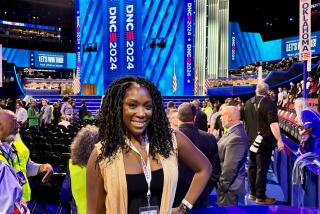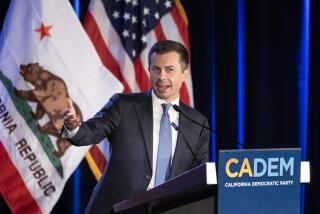Republican Party’s demographic challenge on display at convention
TAMPA, Fla. — Earl Phillip is a North Carolina delegate to the Republican National Convention, a member of the party since he was 18 and a passionate believer in its ideals. He is also African American, which made him stand out this week in a sea of white faces on the floor of the convention hall.
The day he arrived, Phillip said, “I walked out there, I looked around, and I couldn’t count any black folks.”
There were some, eventually, but not a lot. Nor, if he had tried, would he have counted many Latinos or other ethnic and racial minorities — except on the podium, where Republicans showcased their diversity with speakers who reflected the party’s aspirations more than its reality.
Photos: Romney accepts GOP nominationAs the United States steadily shifts from a predominantly white country to one in which nonwhites will soon be a majority, the Republican Party has a demographic challenge.
It does very well, generally speaking, among non-Latino white voters, especially white male voters, who were in abundance at its convention. But the Democratic Party retains a firm hold on most nonwhite voters, who lifted Barack Obama to victory four years ago and remain his greatest base of support this year.
Mitt Romney’s campaign has said it is reaching out to all Americans, and certainly the GOP convention tried to make that case, not only with a diverse cast of speakers but with videotaped testimonials by voters of all races who blamed Obama for the economic hardships they have endured the last four years.
“From the volunteers to the delegates to the speakers on stage, it’s extremely inclusive and pretty diverse,” said Tara Wall, who oversees the Romney campaign’s outreach to ethnic communities. She said Romney’s goal was “an inclusive campaign” that would “take our message into every community.”
According to unofficial figures compiled by the Joint Center for Political and Economic Studies in Washington, blacks accounted for slightly more than 2% of the delegates at the convention. The center does not compile statistics for other groups, and the Republican National Committee does not keep track of the racial or ethnic status of the delegates.
By contrast, the Democratic National Convention in Charlotte, N.C., next week is expected to feature delegates who hew much closer to the demographics of the nation at large.
The gap between the GOP’s aspirations and reality were vividly on display at the convention.
Prime-time television audiences saw speeches by, among others, former Secretary of State Condoleezza Rice, who is black, and New Mexico Gov. Susana Martinez, the nation’s first Latina governor. But as the camera panned over the crowd, black and Latino faces were rare.
There were many appeals to the country’s growing Latino population, including a Spanish-language entreaty by Romney’s son Craig and a video showcasing Latino Republicans. But there also were images of former California Gov. Pete Wilson and Arizona Gov. Jan Brewer — two politicians who inspire antipathy from Latino voters — speaking for their states during the roll call of votes for Romney’s nomination.
Romney alienated many Latino voters when he took a strong stand against illegal immigration in the Republican primary. His camp also has been accused of injecting race into the campaign through an attack on Obama’s welfare policies, drawing accusations that Romney is using political code words to roil white resentment of African Americans.
Republicans say those criticisms are not fair.
“The Republican Party has not said or used any racial code words,” said C.J. Jordan, a GOP strategist who is president of the National Black Republican Leadership Council. “It’s the vice president who said we’re going to ‘put y’all back in chains.’ … That was the sitting vice president!”
She was referring to remarks by Vice President Joe Biden, who told a partially African American crowd that Romney wanted to “unchain Wall Street” and “put y’all back in chains.” He later said the comment was not intended to refer to slavery, but Republicans have criticized him for using racially loaded language.
Polls have shown Romney with a commanding lead over Obama among white voters. It becomes a toss-up, however, when Obama’s strength among minorities is factored in.
In the most recent Gallup poll, the president had a 2-1 lead over Romney among Latinos. Among blacks, his support was close to unanimous: Obama was the choice of 90%, compared with just 4% for Romney. And that is closer than some polls in which Romney’s support was statistically unmeasurable.
Republicans acknowledge the challenge of building minority support, especially during a campaign against the country’s first African American president. Still, they insist they are making an effort. Romney has spoken to minority groups, including the NAACP, and is about to announce formation of an African American support group. Until that happens, black visitors to his campaign website will find links for coalitions of Latino, Asian American and Polish American supporters, among others, but none for African Americans.
Phillip, the North Carolina delegate, said minority voters shared many values with the GOP on social issues and self-reliance, and would come around eventually.
“The problem,” said Phillip, 45, director of a conservative black Christian group, the Frederick Douglass Foundation of North Carolina, “is that the Republican Party doesn’t do a good enough job of sharing our message.”
He noted that black Americans were predominantly Republican for roughly the first century of the party’s existence. That changed when Democrats embraced the civil rights movement and Republicans, in a bid for Southern white votes, began to champion states’ rights. He considers that an anomaly.
“Historically, I could never be a Democrat,” he said.
mitchell.landsberg@latimes.com
More to Read
Get the L.A. Times Politics newsletter
Deeply reported insights into legislation, politics and policy from Sacramento, Washington and beyond. In your inbox three times per week.
You may occasionally receive promotional content from the Los Angeles Times.










